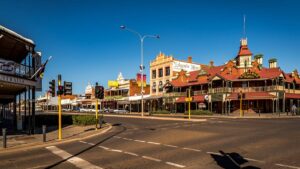Monsters of Rock: Dividends, mine sales and studies, it’s all kicking off today

Pic via Getty Images
- Whitehaven sells coal mine share to Japan as steelmakers issue warning over future met coal supply
- Gold beast Northern Star lobs record returns to shareholders on bumper $639m profit
- More on Regis’ red tape debacle and Patriot drops Shaaki (not shaky) study
Whitehaven Coal (ASX:WHC) will pocket more than US$1 billion from the partial sale of its Blackwater coal mine, in a deal that makes its US$4.1bn purchase from BHP of that and the Daunia mine as well as the Blackwater South development asset look cheap by comparison.
Elsewhere in the market Northern Star Resources (ASX:NST) lobbed a 25c dividend to take the leading Aussie gold miner’s FY24 payout to a record 40c on a $639 million profit, $4.9bn in revenue and $2.2bn in underlying EBITDA with its full-year return before share buybacks totalling ~$460m or 25.5% of its $1.8bn in cash earnings. $172m has been returned through a max. $300m share buyback, which is being continued.
Also, Regis Resources (ASX:RRL) booked a $192m impairment on its McPhillamys project after deciding a ruling by enviro minister Tanya Plibersek on the NSW gold mine’s aboriginal heritage impacts made the $1bn project unviable. Regis made $421m in underlying EBITDA but booked a $266m loss before tax and $186m loss after tax on the impairment and hedge losses. Hedges are now cleared, with RRL having a record $295m in cash and bullion on its books.
And Patriot Battery Metals (ASX:PMT) put a C$640m (US$487m) price tag on the construction of a 400,000tpa spodumene operation at the Shaakichiuwaanaan project in Canada’s James Bay region, including government tax credits, in a preliminary economic assessment at a future 6% lithium price of US$1500/t, roughly double today’s levels. The mine is expected to reach FID in 2027 and be in production by 2029, with a high-grade option flagged to weather the storm of lower prices, with a ~US$560/t total cash cost flagged for the first stage.
A second C$408m (US$310m) stage would make the mine an 800,000tpa producer, the third largest hard rock operation globally behind WA’s Greenbushes, Pilgangoora and Wodgina.
Japanese canary in the coal market
Whitehaven Coal will be able to cover any future payments due to BHP by banking US$1.08bn from Japans Nippon Steel and JFE Steel for 30% of the Blackwater coal mine in Queensland. It highlights the continued importance of met coal to global steelmakers, indicating the long-term outlook for the commodity as green steel technologies take longer to emerge than many observers had hoped.
Nippon, which will take a 20% stake worth US$720m, said higher royalty rates in Queensland had made it concerned new supply will not be brought online, placing a premium on existing operations.
“Currently, there are growing concerns that capital investment in coal assets will shrink due to the implementation of policies to raise coal royalty rates in Australia’s states, which hold significant influence over the supply of steelmaking coal to the seaborne market,” Nippon said in a statement.
“This will certainly contribute to a decrease in the supply of steelmaking coal in the long term. Given the strong sense of urgency in respect to this decrease in the supply of steelmaking coal, Nippon Steel has determined that, as an end-user of steelmaking coal, it is necessary to invest in the BW Coal Mine to secure a long-term stable supply of coking coal required for Nippon Steel’s technologically advanced coke production.”
Given WHC paid BHP US$3.2bn last year for both Blackwater and Daunia with US$900m in payments deferred contingent on prices and milestones, it shows how concerned customers are on the future of coking coal supply.
It comes at an interesting point in the composition of the met coal market, with Anglo American placing its 16Mtpa Queensland operations on the market earlier this year and Glencore dumping plans to demerge its coal assets after prettying them up from an ESG perspective by adding Teck’s Elk Valley met coal mines in British Columbia, Canada to its Aussie and Colombian energy coal ops.
Thermal coal miners and steelmaking customers are lining up to diversify into met coal mine ownership, with Chinese-backed Yancoal Australia (ASX:YAL) controversially dumping its previously attractive dividend to keep its powder dry for a deal in the steel mill supply market. That decision came despite YAL boasting $1.55bn in cash and no debt, an indicator of the prices miners will be willing to pay to get their hands on premium coking coal assets.
WHC issued a 13c dividend after spitting out $3.8bn in revenue for FY24, forecasting production of 35.0-39.5Mt including 17.6-19.7Mt from its Queensland coking coal mines in FY25 at costs of between $140-155/t. The balance will come from its thermal coal dominant NSW ops. On an equity basis, WHC expects to sell 25.1-28.3Mt of the fossil fuel in FY25 and spend between $440-550m on capex.
Lower coal prices saw WHC’s revenue fall 37% in FY24, with underlying EBITDA down 65% to $1.4bn and statutory NPAT 87% lower at $355m. That included stamp duty considerations on the BHP deal, with underlying NPAT 72% lower from $2.668bn to $740m. While they carry higher operating costs, the met coal mines will boost WHC’s average prices, pulling $271/t in the June quarter against $217/t at its thermal coal mines for FY24.
Front month premium hard coking coal futures are trading at US$198/t, but WHC boss Paul Flynn is hopeful of seeing higher prices as Indian purchasers return to the market after a traditionally down season for steelmakers. He said while WHC would like to see prices above the US$200-205/t range seen recently, the purchase of Blackwater and Daunia was a long-term strategy.
Flynn views the Japanese steelmakers’ purchase of the Blackwater stake as a sign of what customers see in coal’s long-term future as well.
“The key point here is these are both important and material consumers of both products, the semi-hard and the semi-soft out of Blackwater and it’s obviously important enough to put their money to work here to ensure they have consistency of supply over time,” WHC boss Paul Flynn said.
Star performer
RBC analyst Alex Barkley called Northern Star ‘cheap’ after it beat analyst dividend estimates by ~10% in its full-year results, as boss Stuart Tonkin mulls the impact of higher gold prices on the expanding gold miner’s plans.
The rise of gold prices to record levels this week comes as it plots a lift in production from ~1.6Moz to 2Moz by FY26, before growing further in the latter part of the decade with a $1.5bn expansion of the Super Pit’s processing plant that will double its production at the flagship KCGM Golden Mile asset to 900,000oz by 2029.
Barkley, who has an outperform rating and $16.50 PT on NST, said the result came in ahead of expectations in some key metrics.
“The higher dividend payout vs consensus is likely to be well-received. Additionally, Net debt has finished A$100m better than consensus. This could give investors some confidence of NST’s capital position as it constructs the high cost KCGM mill expansion,” he said.
Tonkin, meanwhile, is facing questions on how higher gold prices will affect the company’s strategy as it spits out additional cash, with a near record US$2516/oz around 20% higher than the start of calendar 2024. He warned cost inflation could return as previously uneconomic mines are switched on and compete for labour, resources and capital.
NST’s investors, he said, want to see costs remain stable or trend down so higher gold prices actually result in stronger margins.
“What does happen across the gold sector generally is those mines that were binary, that need this price to be open, they potentially turn on, which then competes with our labour or resources that we already have deployed, and then that puts cost pressure back across us,” he warned.
“So they’re not decisions that we make, but we know at this gold price, there’s a lot of things around Kalgoorlie that suddenly become economic.
“It might even just mean drill rigs. For us to deliver on a $200 million exploration budget, suddenly all the drilling fleet get reapplied to go and look for stuff, because it’s suddenly worth more.
“If it stays up for a long time, costs, as we know, do trend to that 60-70% of gold price and costs tend to trend up because of the general behaviour across the gold sector.
“There’s nothing wrong with that, because it’s making good margins and good cash. I guess the feedback we get from investors is costs should go flat or down as price goes up and margin should be expanded and returned to shareholders. It’s not always the case.”
“Unhedged, not unhinged”
Regis boss Jim Beyer declared the gold miner ‘unhedged, not unhinged’ on the gold miner’s conference call today to outline its FY results.
Investors who have seen it push on with the McPhillamys project despite spiralling costs and uncertainty around an Aboriginal heritage application, which has now “surprisingly” gone against the company, may beg to differ.
It’s down almost 25% since April 19 despite a run in gold prices to record highs and the fact that closing those hedges has given RRL access to those +$3700/oz bullion prices.
As far as positives are concerned, RRL has $5m in net debt with CFO Anthony Rechichi saying the operating business is in great shape.
Regis produced 418,000oz at an all-in sustaining cost of $2286/oz in FY24, but is expected a leg down in production in FY25, with guidance set of 350-380,000oz at an AISC of $2,440-$2,740/oz including $150/oz for non-cash stockpile charges.
Beyer got more serious on his comments about the s10 debacle, which has seen the mining industry up in arms against the Federal government’s environment policies.
He denied claims the banned tailings dam would have caused irreparable damage to the Belubula River headwaters, a cultural site for the local Wiradyuri People, taking aim at commentary from the Nature Conservation Council of New South Wales that compared the potential impact to Rio Tinto’s 2020 destruction of Juukan Gorge.
“After the mine’s closed, after all of the rehabilitation is finished the reduction in water flow into the (Carcoar) Dam is less than 0.5%,” Beyer said. “So I’m not sure how that could be considered to be an action that destroys the river.
“The bigger concern for us is after years of work, testing, surveying the land, surveying for heritage, drilling, investigations, expert advice, State and Federal approvals and spending hundreds of millions of dollars, a decision can be made that overturned all of this and we really don’t know why.
“If there’s one thing the country needs it’s consistency.”
With McPhillamys out of the equation, Regis is now looking at the potential to either return to paying dividends or make a new acquisition to add to its Duketon and minority owned Tropicana JV, though its debt pile could constrain capital management decisions.
“I’d certainly say it’s a genuine agenda item that the board has been discussing,” Beyer said.
“We still have $300m in debt that we can’t lose site of and also I think we’ve chewed through for now all of our franking credits.”
Shaaking it up
There have been a fair few disappointments in the critical minerals space of late, with investors often getting the jitters on highly-touted projects once studies begin to roll out.
On immediate reading, Ken Brinsden’s Patriot Battery Metals looks to have avoided that pitfall with the initial study on its Shaakichiuwaanaan project in Canada’s James Bay region received with a near 3% lift in morning trade on the ASX.
At 80.1Mt indicated at 1.44% Li2O and 62.5Mt inferred at 1.31% Li2O, the Quebecois deposit is one of the largest hard rock spodumene lithium orebodies in the world, with an exploration target that could put it in the same order of magnitude as WA mines like Pilgangoora – mined by Brinsden’s former employer Pilbara Minerals (ASX:PLS).
Vital signs are, for a 400,000tpa (5.5% Li2O concentrate grade) operation, a US$487m pricetag including govt tax credits running for 24 years as an open pit mine with commissioning to begin in 2028. NPV8 is set at C$2.9 billion (US$2.2bn) with a 34% after-tax IRR.
The hope is the market has turned around a bit by then (SC6 prices are forecast at US$1500/t in the study) with demand from North American carmakers expected to rise and require local sources of raw materials to compete with Chinese competitors.
An option for weaker economic conditions could be to high grade it. The Nova zone contains around 21Mt at over 2% Li2O – grades only seen in the Greenbushes mine in WA’s South West. A second stage including the development of Nova as an underground and doubling of plant capacity from 2.5 to 5Mtpa could see the mine produce up to 800,000tpa.
The materials sector closed the day up 0.56% as miners continue to see favour following last week’s hammering.
Making gains
Whitehaven Coal (ASX:WHC) (coal) +6.25%
Pilbara Minerals (ASX:PLS) (lithium) +2.04%
Fortescue (ASX:FMG) (iron ore) +2.0%
Northern Star Resources (ASX:NST) (gold) +5%
Eating losses
Alcoa Corporation (ASX:AAI) (bauxite / alumina) -2.36%
Emerald Resources (ASX:EMR) (gold) -1.93%
Spartan Resources (ASX:SPR) (gold) -1.81%
Resolute Mining (ASX:RSG) (gold) -0.73%
Related Topics

UNLOCK INSIGHTS
Discover the untold stories of emerging ASX stocks.
Daily news and expert analysis, it's free to subscribe.
By proceeding, you confirm you understand that we handle personal information in accordance with our Privacy Policy.








